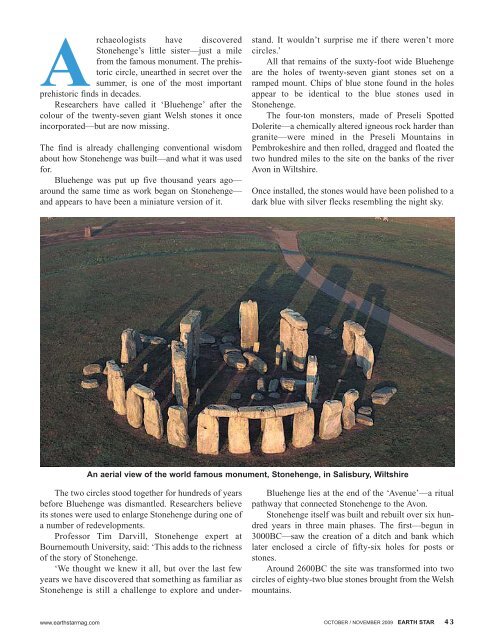WILD ATTRACTION WILD ATTRACTION - Earthstar
WILD ATTRACTION WILD ATTRACTION - Earthstar
WILD ATTRACTION WILD ATTRACTION - Earthstar
- No tags were found...
Create successful ePaper yourself
Turn your PDF publications into a flip-book with our unique Google optimized e-Paper software.
Archaeologists have discoveredStonehenge’s little sister—just a milefrom the famous monument. The prehistoriccircle, unearthed in secret over thesummer, is one of the most importantprehistoric finds in decades.Researchers have called it ‘Bluehenge’ after thecolour of the twenty-seven giant Welsh stones it onceincorporated—but are now missing.The find is already challenging conventional wisdomabout how Stonehenge was built—and what it was usedfor.Bluehenge was put up five thousand years ago—around the same time as work began on Stonehenge—and appears to have been a miniature version of it.The two circles stood together for hundreds of yearsbefore Bluehenge was dismantled. Researchers believeits stones were used to enlarge Stonehenge during one ofa number of redevelopments.Professor Tim Darvill, Stonehenge expert atBournemouth University, said: ‘This adds to the richnessof the story of Stonehenge.‘We thought we knew it all, but over the last fewyears we have discovered that something as familiar asStonehenge is still a challenge to explore and understand.It wouldn’t surprise me if there weren’t morecircles.’All that remains of the suxty-foot wide Bluehengeare the holes of twenty-seven giant stones set on aramped mount. Chips of blue stone found in the holesappear to be identical to the blue stones used inStonehenge.The four-ton monsters, made of Preseli SpottedDolerite—a chemically altered igneous rock harder thangranite—were mined in the Preseli Mountains inPembrokeshire and then rolled, dragged and floated thetwo hundred miles to the site on the banks of the riverAvon in Wiltshire.Once installed, the stones would have been polished to adark blue with silver flecks resembling the night sky.An aerial view of the world famous monument, Stonehenge, in Salisbury, WiltshireBluehenge lies at the end of the ‘Avenue’—a ritualpathway that connected Stonehenge to the Avon.Stonehenge itself was built and rebuilt over six hundredyears in three main phases. The first—begun in3000BC—saw the creation of a ditch and bank whichlater enclosed a circle of fifty-six holes for posts orstones.Around 2600BC the site was transformed into twocircles of eighty-two blue stones brought from the Welshmountains.www.earthstarmag.com OCTOBER / NOVEMBER 2009 EARTH STAR 43
















